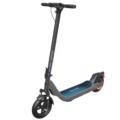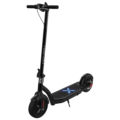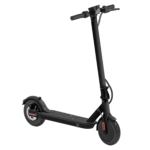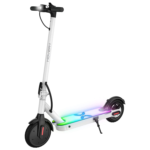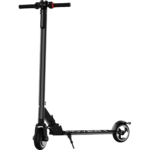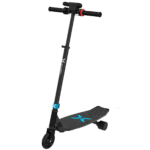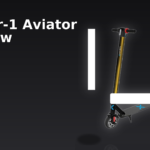- Home
- Scooters
- Electric Scooters
- Hover-1 Pioneer
Hover-1 Pioneer
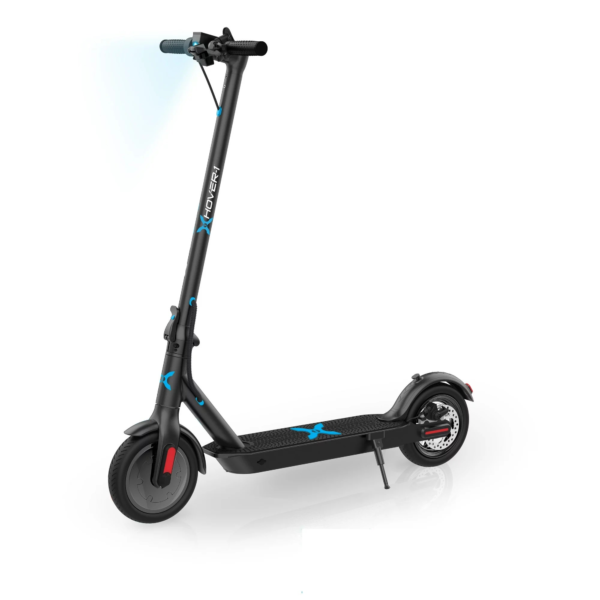

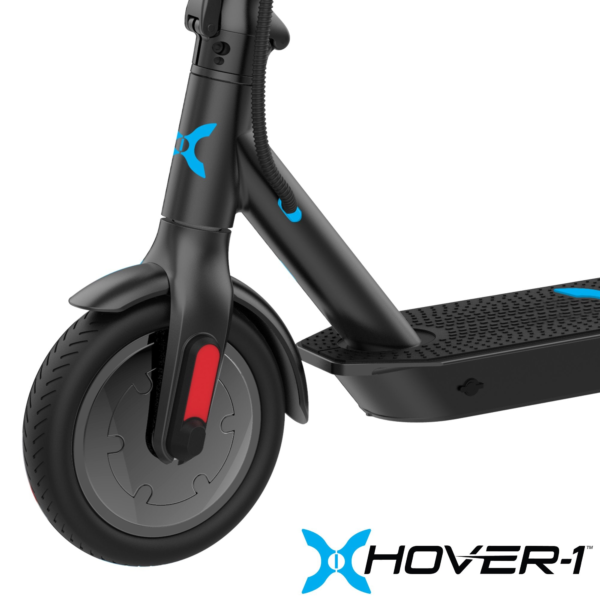
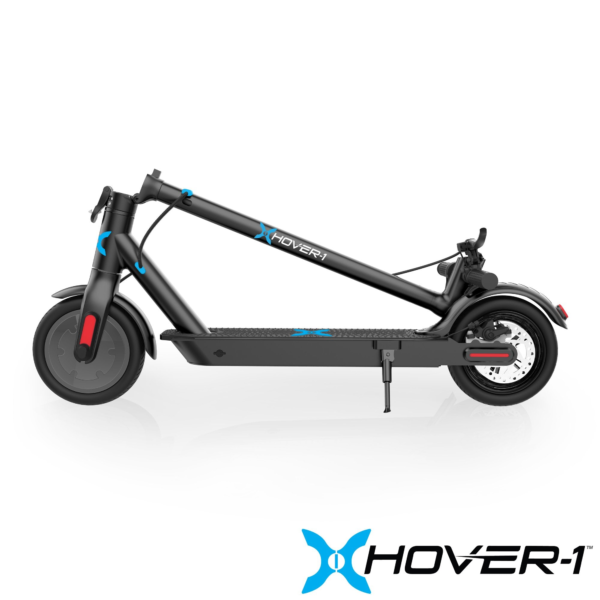
- Battery Range: 16 miles (26 km)
- Top Speed: 14 mph (23 km/h)
- Motor Power: 300 W
- Weight Capacity: 264 lb (120 kg)
- Charging Time: ~5 h
- Scooter Weight: 26.7 lb (12.1 kg)
PROS
- 300W brushless hub motor
- 16-mile claimed range
- 8.5″ pneumatic tires
- Rear disc brake
- 264 lb capacity
CONS
- No suspension
- No stated IP rating
- Basic feature set (no app)
Table of contents
- What Is the Hover-1 Pioneer?
- How the Hover-1 Pioneer Works
- Key Specifications
- Design & Build Quality
- Performance Fundamentals
- Battery, Range & Efficiency
- Ride Quality & Comfort
- Braking & Safety Features
- Portability & Daily Usability
- Maintenance & Care
- Weather & Seasonal Considerations
- Hover-1 Pioneer vs Alternatives
- Who the Hover-1 Pioneer Is (and Isn’t) For
- FAQs
- Glossary
- Final Thoughts
If you want a straightforward first scooter that’s easy to ride, the Hover-1 Pioneer fits the bill. It’s a compact, entry-level commuter with a simple fold, a clear display, and enough power for short urban trips. Moreover, it balances weight, range, and approachable controls, so it suits students, first-time riders, and last-mile commuters who prefer predictable handling over raw speed. If you’re shopping for a starter model for younger or smaller riders, also consider the Hover-1 My First E-Scooter.
What Is the Hover-1 Pioneer?
The Hover-1 Pioneer is a lightweight, foldable electric scooter built for everyday pavement rides. It uses a 300-watt brushless hub motor, a 36-volt lithium-ion battery, and 8.5-inch pneumatic tires to deliver up to 14 mph (22.5 km/h) top speed and a rated 16 miles (25.8 km) of range in ideal conditions. Furthermore, it folds quickly, travels easily, and keeps controls simple: a thumb throttle on the right, a single brake lever on the left, and an LCD down the middle.
Because the design favors ease of use, the Pioneer is not a high-power hill crusher or an off-roader. Instead, it prioritizes reliability for short to medium urban hops. You get a bell, a headlight, a brake light, and a kickstand included. There’s also cruise control for relaxed flat-ground cruising, which you can toggle from the cockpit. Consequently, the learning curve stays short while day-to-day riding feels calm.
How the Hover-1 Pioneer Works
Although electric scooters can seem complex, the Pioneer’s systems are easy to understand. Therefore, here’s a plain-English walkthrough of how each piece does its job.
Motor (what makes it go).
A 300W brushless hub motor sits inside the rear wheel. When you press the thumb throttle, the controller sends current to the motor windings. Because the motor is brushless, it has fewer wear parts and runs quietly. In short, it behaves like a fan that spins only when current flows; more current means more torque for takeoff and hills.
Controller (the scooter’s “brain”).
The controller lives inside the deck and meters battery power to the motor in response to your throttle input. It also enforces safety limits, such as low-voltage cut-off and over-temperature protection, so the system avoids damage. Additionally, when you switch between low and high speed modes, the controller changes the power map to match.
Battery (your fuel tank).
A 36V, 6Ah lithium-ion pack sits inside the deck. That’s 216 Wh of energy (volts × amp-hours). Because energy is finite, riding style matters. Smooth cruising stretches range; repeated hard launches reduce it. Meanwhile, temperature and terrain also affect how far you’ll go.
Throttle (how you command speed).
The Pioneer uses a right-hand thumb throttle. Push gently and you roll away; press further and the controller feeds more current to the motor. For safety, it uses kick-to-start: you must nudge the scooter to about 1.8 mph (3 km/h) before the motor will engage. As a result, accidental bumps to the throttle won’t shoot the scooter forward.
Brakes (how you slow and stop).
You get a rear mechanical disc brake controlled by a left-hand lever. Pull lightly for speed trimming or firmly when you need a brisk stop. Because braking loads the rear tire, keep your weight centered or slightly back for stability. Consequently, stops feel controlled rather than abrupt.
Key Specifications
(All values presented in both imperial and metric for clarity.)
General
| Item | Spec |
|---|---|
| Model | H1-PNR |
| Net Weight | 26.7 lb (12.1 kg) |
| Supported Rider Weight | 44–264 lb (20–120 kg) |
| Tire Type & Size | 8.5 in pneumatic (front & rear) |
| Frame/Deck | Foldable aluminum chassis with textured deck |
| Display | Central LCD with speed, battery, mode, and indicators |
Performance & Power
| Item | Spec |
|---|---|
| Motor | 300W brushless hub (rear) |
| Top Speed | Up to 14 mph (22.5 km/h) |
| Riding Modes | Low / High speed modes |
| Cruise Control | Yes (cockpit toggle) |
Battery, Charging & Electrical
| Item | Spec |
|---|---|
| Battery | 36V, 6Ah lithium-ion (216 Wh) |
| Rated Range | Up to 16 mi (25.8 km) in ideal conditions |
| Charge Time | Up to 5 hours |
| Charger Input | AC 100–240V, 50/60 Hz |
| Operating Temp | 32–104°F (0–40°C) |
| Storage Temp | -4–104°F (-20–40°C) |
Build & Dimensions
| Item | Spec |
|---|---|
| Open Size (L × W × H) | 42 × 16.5 × 44.8 in (107 × 42 × 114 cm) |
| Folded Size (L × W × H) | 42 × 16.5 × 19.2 in (107 × 42 × 49 cm) |
| Folding Mechanism | Column latch with safety lock and hook |
| Kickstand | Yes, side-mounted |
Safety & Control
| Item | Spec |
|---|---|
| Brake | Rear mechanical disc, lever-actuated |
| Lighting | Headlight (power-button double-press), brake light |
| Audible Signal | Bell |
| Reflectors | Not built-in; use reflective gear as needed |
| Water Exposure | Avoid rain and puddles; store dry |
Features & Extras
| Item | Spec |
|---|---|
| Cruise Control | Yes (indicator on LCD) |
| Kick-to-Start | Yes (engages above ~1.8 mph / 3 km/h) |
| Display Readouts | Speed (mph), battery bars, mode, icons |
| Folding Hook | Locks stem to rear area for carrying |
| Included in Box | Scooter, charger & cable, air pump, Allen keys & bolts, manual |
Warranty & Compliance
| Item | Spec |
|---|---|
| Manufacturer | DGL Group, Ltd., Edison, NJ |
| Warranty | Limited manufacturer warranty (see included materials) |
| Compliance Notes | Follow local riding laws and age/weight guidance |
Design & Build Quality
The Pioneer’s structure is simple and sturdy, which suits its mission. The aluminum frame keeps weight low and resists corrosion when stored properly. The stem is tall enough for average adults, and it locks with a familiar collar-style latch and a secondary safety clip. Because the latch is mechanical, you feel it click into place. Consequently, a quick pre-ride check of the hinge becomes second nature.
The deck carries the battery and offers a grippy, rubberized surface. There’s enough room for a natural stance—front foot angled, back foot straight—without feeling cramped. Additionally, you can rotate your rear foot slightly for more leverage under braking, which increases confidence in busy areas.
The cockpit is uncluttered. On the left, the brake lever and bell sit where your fingers expect them. On the right, the thumb throttle lets your hand stay relaxed over bumps. The LCD is bright enough for cloudy days and shows speed in mph, battery level, and mode. Because the headlight toggles with a quick double-press of the power button, you don’t have to reach for a separate switch. Likewise, the cruise indicator confirms when speed hold is active.
Fit-and-finish matches an entry-level commuter: clean welds, simple cable routing, and a practical folding hook to secure the stem for carry. The kickstand is small yet effective. However, since the deck houses the battery, avoid curb strikes; lift the scooter over sharp transitions rather than dragging the belly. Over time, that habit preserves both clearance and cosmetics.
Performance Fundamentals
Acceleration feel.
Off the line, the Pioneer starts smoothly. The kick-to-start requirement prevents accidental launches, which helps new riders. In low mode, throttle response feels gentle; in high mode, it’s more eager but never abrupt. Consequently, you won’t snap forward, yet you will clear intersections with confidence if you plan your gaps.
Cruising stability.
At 10–12 mph (16–19 km/h), the scooter tracks straight, and the 8.5-inch pneumatic tires soak up small surface chatter. Because the wheelbase is modest, body position matters. Keep your knees slightly bent and arms loose. Near the 14 mph (22.5 km/h) ceiling, the steering remains light, so avoid sudden inputs on rough pavement. Nevertheless, the chassis stays composed when you ride predictably and scan ahead.
Hill-climb behavior (7–10% grades).
On short 7% neighborhood rises, the 300W motor holds a jogging pace if you enter with a little speed. Rider weight affects results; lighter riders keep momentum longer. On 10% pitches, speed drops noticeably, and you may prefer to assist with a push for the last few yards. Even so, the controller will protect the motor if it gets hot, so don’t force long, steep climbs back-to-back. Instead, give the deck a brief rest and continue once temperatures normalize.
Battery, Range & Efficiency
The battery is 36V, 6Ah (216 Wh). That capacity aligns with a short-to-medium daily loop rather than a half-day trek. The rated range is up to 16 miles (25.8 km) in ideal conditions, which typically means a light rider on flat ground at a steady pace with minimal stops. In practice, real-world factors shape outcomes; therefore, plan conservatively and build in margin.
- Rider weight. Heavier riders draw more current at the same speed. As a result, the percentage of battery used per mile increases.
- Terrain. Hills and rough surfaces cost energy. Consequently, routes with repeated climbs reduce total distance.
- Temperature. Batteries prefer mild conditions. In cold weather, internal resistance rises and capacity drops. Thus, expect fewer miles near freezing.
- Speed & style. Smooth, steady cruising at 9–12 mph (14–19 km/h) stretches range. By contrast, frequent sprints to top speed shorten it.
Charging best practices.
Because the pack is lithium-ion, treat it kindly. After a ride, let the scooter rest for a few minutes before charging. Top it up to full if you need the maximum range next day. If you won’t ride for weeks, store the battery in a dry, cool place and charge it periodically so it doesn’t sit near empty. The manual lists an up to 5-hour full charge; actual time depends on how much you used. Additionally, always use the included charger, keep the port clean, and avoid bending the pin. Since the charger’s indicator changes at full, disconnect once topped to minimize stress.
Finally, keep a simple log of charge times and ride distances. Over months, you’ll spot patterns; consequently, you’ll learn how temperature and route choices influence your typical range.
Ride Quality & Comfort
The Pioneer rides on 8.5-inch air-filled tires. Because they’re pneumatic, you get natural damping without the complexity of springs or shocks. They mute brick seams and small pothole edges better than solid tires at this size. However, sidewall support on budget commuter tires is modest, so ride at a pace that lets you avoid sharp-edged holes. Likewise, maintain the recommended pressure (check the sidewall) to keep casing support consistent.
The stem has normal, light flex for a scooter of this weight. You’ll feel some vibration over coarse asphalt, but the deck stays composed. Grips are basic rubber and, therefore, easy to clean. If you commute daily, consider padded gloves for winter mornings; they reduce hand fatigue and improve lever feel. Meanwhile, the deck’s low height helps stability, since you don’t need to climb far to step on.
Ergonomics are forgiving. The brake lever has a moderate reach; you can adjust your grip so two fingers pull the brake while the others hold the bar. The throttle’s resistance is light, so long flat sections pair well with cruise control, which takes over speed holding until you tap the lever or pull the brake. As a result, hand and wrist fatigue drop on extended straightaways.
Braking & Safety Features
The rear mechanical disc brake provides predictable control. Initial travel is light, then bite increases as the pads grip. Because braking weight transfers forward, keep your weight balanced and don’t stab the lever; squeeze progressively. On damp mornings, rotors can film with moisture; one light squeeze early in the ride wipes them dry. Therefore, you regain full feel quickly without surprise.
Lighting covers the essentials. There’s a headlight you can toggle with the power button and a brake light that flashes under braking. The manual notes the scooter does not include reflectors, so add reflective clothing or small adhesive reflectors for dusk commutes. Because the manual also advises against riding in rain or through puddles, treat the Pioneer as a fair-weather commuter. Consequently, you’ll extend component life and avoid electrical issues.
Regarding protection ratings, the Pioneer has no published IP rating. Therefore, assume splash resistance is minimal and store the scooter indoors away from humidity. Additionally, dry the deck and wheels before carrying into buildings to avoid slick floors.
Portability & Daily Usability
At 26.7 lb (12.1 kg), the Pioneer is carryable for short flights of stairs and train transfers. The fold is quick: pop the latch, tip the stem down, engage the hook, and you’re ready to hand-carry. Because the folded height is only 19.2 in (49 cm), it slides under most desks and many café tables. However, the length remains 42 in (107 cm), so be mindful in tight elevators.
For locking, treat the Pioneer like a bicycle: use a sturdy lock through the frame and a fixed object. Since the brake is only on the rear, avoid yanking the lever while the scooter is folded; it can scuff the rotor if the wheel moves against a surface. Instead, carry by the stem or deck cutout and keep the rear wheel free.
If your commute mixes walking with riding, you’ll appreciate the light overall package and the low step-on height. Keep a small microfiber cloth at your desk to wipe the deck when you enter buildings. Additionally, bring a compact pump; a quick pressure touch-up before the ride home preserves handling and reduces pinch-flat risk.
Maintenance & Care
Because the design is simple, routine care is simple too. Consequently, small, regular checks go a long way. Here’s a practical, low-effort schedule:
Before every ride (30 seconds).
- Quick hinge check: verify the folding latch and safety clip are fully engaged.
- Squeeze the brake once to confirm firm lever feel.
- Scan tires for visible cuts or low pressure; top up to the sidewall rating when needed.
- Confirm the headlight works if you’ll ride near dusk.
- Finally, make sure the display reads a sensible battery level for your route.
Weekly (5–10 minutes).
- Inspect rotor and brake pads for contamination. If the lever suddenly feels spongy, check caliper alignment and cable tension.
- Check deck fasteners and stem clamp bolts for tightness. Tighten gently; don’t overtighten and crush threads.
- Wipe dust from the display and light lenses so outputs and readouts stay clear.
- Additionally, listen for new creaks; they often point to a bolt that needs a quarter-turn.
Monthly (15–20 minutes).
- Deep clean with a damp cloth—never soak the scooter. Avoid spraying water into bearings, ports, or the deck.
- Examine tires for embedded debris; remove small stones before they work deeper.
- Charge the battery fully and observe charge time; if it climbs well beyond normal, contact support.
- Moreover, inspect the brake cable housing for kinks and the rotor for warp.
Storage care.
Keep the scooter dry and ventilated. If you’ll store it for weeks, charge to a comfortable level and check every month so the pack doesn’t sit empty. Avoid extreme heat and keep it out of direct sun in parked cars. Likewise, store the charger off the floor in a clean, dry spot.
Weather & Seasonal Considerations
Rain.
Because there’s no listed IP rating and the manual advises against water exposure, avoid riding in the rain. Wet braking distances grow, traction shrinks, and spray can reach electronics. If you get caught in a sprinkle, slow down, avoid paint lines, and dry the scooter afterward. Then, once indoors, let the deck air out before charging.
Cold.
Around freezing, lithium-ion chemistry yields less energy. Consequently, range drops and voltage sags under load. Warm the scooter indoors before charging, and expect gentler acceleration as a smart trade-off. Additionally, consider slightly lower tire pressures (within the safe range) for grip on cold surfaces.
Heat.
High temperatures stress the battery and controller. Don’t leave the scooter in a hot car or against a sun-baked wall. If the deck feels very warm after a climb, give it a rest. Meanwhile, store it in the shade during lunch breaks, which helps preserve cycle life.
Traction.
Pneumatic tires grip well on clean pavement, but sand, leaves, and gravel demand caution. Roll off the throttle before patches, keep the scooter upright, and use the brake smoothly. Furthermore, approach wet metal grates and painted crosswalks at a gentle, straight-line pace.
Hover-1 Pioneer vs Alternatives
Electric scooters cluster into three broad families: lightweight commuters, mid-power commuters, and performance or off-road models. The Hover-1 Pioneer sits at the front of the lightweight group.
Where the Pioneer excels.
- First rides and learning. Smooth throttle maps, kick-to-start, and a clear display build confidence.
- Short urban loops. Up to 2–6 miles each way on mostly flat ground is its sweet spot.
- Carry and storage. At under 27 pounds with a compact fold, it’s easy to bring on buses and into classrooms.
- Predictable control. Because braking is mechanical and direct, new riders sense what the tire is doing.
Where a larger class may fit better.
- Steep, sustained hills. If your commute climbs long 10% grades, a higher-power motor and larger battery will feel calmer.
- Higher-speed suburban arterials. Riders who want 20+ mph cruising with wider decks and longer wheelbases should look at mid-power models.
- Rough surfaces. For frequent unpaved or broken asphalt rides, scooters with suspension and larger tires deliver more comfort and margin.
- Extended range. If you regularly need 18–25 miles per charge, step up to bigger batteries to reduce charging frequency.
Ultimately, match the tool to the job. When your routes and expectations align with what the Hover-1 Pioneer does well, ownership feels easy and stress-free.
Who the Hover-1 Pioneer Is (and Isn’t) For
Great for:
- Students and campus riders. Simple controls, easy carrying, and quick charging make it ideal for class-to-class moves.
- Last-mile commuters. Ride to the train, fold, and finish the trip without breaking a sweat.
- New riders. The pacing is friendly, and the brake feel is intuitive.
- Apartment living. Because it stores under a desk or in a closet, it suits small spaces.
Not ideal for:
- Heavy hill routes. Short neighborhood climbs are fine, but long, steep grades will sap speed.
- Rain-or-shine riders. There’s no IP rating, and the manual discourages wet use.
- Speed seekers. The 14 mph cap keeps things modest by design.
- Long suburban loops. If you need wide-open speed and big batteries, you should consider a different class.
Therefore, if you value portability, simplicity, and low-stress rides, the Hover-1 Pioneer serves as a practical daily companion.
FAQs
1) How fast does the Hover-1 Pioneer go?
It’s rated for up to 14 mph (22.5 km/h) on level ground in favorable conditions. However, wind, grade, and rider weight influence actual top speed.
2) What is the real-world range?
The rated figure is up to 16 mi (25.8 km). In practice, expect less with hills, stops, colder weather, or brisk riding. Conversely, smooth, steady cruising at neighborhood speeds gives the best results.
3) Does it have cruise control?
Yes. You can enable cruise control from the cockpit; it holds speed until you tap the throttle or pull the brake. Consequently, your throttle hand rests during long flats.
4) Can I ride it in the rain?
No. There’s no published IP rating, and the manual advises against rain and puddles. Therefore, keep it dry and store it indoors.
5) What size are the tires, and are they air-filled?
They’re 8.5-inch pneumatic tires front and rear. Because they’re air-filled, they ride more comfortably than solid tires at this size.
6) Does the Pioneer have regenerative braking?
No. Braking is handled by a mechanical rear disc. Use smooth, progressive lever pulls for the best control. If you want energy recovery, you’ll need a different scooter class.
7) Where can I find a concise Hover-1 Pioneer overview?
You’re reading it. This Hover-1 Pioneer overview covers the essentials: what it is, how it works, and how to care for it.
Glossary
- Ah (Amp-hours): Battery capacity measure; the Pioneer has 6Ah at 36V.
- Wh (Watt-hours): Total stored energy; volts × amp-hours. 216Wh here.
- Brushless Hub Motor: Electric motor built into the wheel; fewer wear parts, quiet operation.
- Controller: The electronics that meter power from battery to motor and enforce safety limits.
- Kick-to-Start: System requires a small push before the motor engages, preventing accidental launches.
- Pneumatic Tire: Air-filled tire that cushions bumps and improves grip.
- Disc Brake: Brake system that clamps pads onto a metal rotor for stopping power.
- Cruise Control: Electronic speed hold that reduces throttle hand fatigue on flat routes.
- Stem Flex: Slight movement in the handlebar column under load; normal in lightweight commuters.
- IP Rating: Ingress protection against dust and water; not published for this scooter.
- BMS (Battery Management System): Internal circuitry that protects the battery from over-charge, over-discharge, and overheating.
- Torque: Rotational force from the motor; affects hill starts and takeoff.
- Regenerative Braking: System that recovers energy under braking; not present on the Pioneer.
- Sidewall Pressure Rating: The PSI guidance printed on the tire; follow it when inflating.
- WOT (Wide-Open Throttle): Riding with the throttle fully pressed; it reduces range.
- PSI (Pounds per Square Inch): Tire pressure unit; check both tires regularly.
Final Thoughts
The Hover-1 Pioneer is purpose-built for straightforward city travel. It’s light, approachable, and quiet. It launches smoothly, cruises happily at neighborhood speeds, and folds in seconds for train doors and stairwells. Although it won’t flatten big hills or power through storms, it excels when the route is sensible and the rider wants a low-maintenance, low-stress commute. Treat the battery well, avoid wet roads, and keep the tires topped to their sidewall rating. In return, the Hover-1 Pioneer delivers a reliable daily rhythm at a friendly pace.
Specifications
General
| Model The Model specifies the exact version or name of the scooter. It helps identify its unique design, features, and specifications within the manufacturer’s product line. Knowing the model makes it easier to compare options, find compatible accessories, or look up support information. | Pioneer |
| Brand The Brand identifies the manufacturer or company that designs and produces the scooter. A trusted brand is a sign of quality, reliability, and good customer support. Well-known brands often have higher standards for safety, performance, and after-sales service, giving you more confidence in your purchase. | Hover-1 |
| Release Date The Release Date indicates when the scooter model was officially launched on the market. This helps you know how current the design, technology, and features are. A newer release date often means updated components, improved performance, and the latest safety or smart features. | 17 November 2025 |
| Recommended Age Recommended Age indicates the minimum age range that the scooter is designed for, based on safety, size, and ease of use. Following the recommended age helps ensure that riders can handle the scooter’s speed, weight, and controls comfortably and safely. Always check local laws and use protective gear, especially for younger riders. | 12+ |
Performance & Power
| Motor Power (Wattage) What it means: The motor power, measured in watts (W), shows how strong the scooter’s electric motor is. Why it matters: Higher wattage usually means better acceleration, more torque, and improved performance on hills or rough terrain. For example, a 250W motor is good for flat city roads and light riders, while a 500W or 1000W motor provides more power for faster speeds or climbing steep inclines. | 300 W rear hub (brushless) |
| Top Speed The Top Speed indicates the maximum speed that the scooter can reach under optimal conditions. It’s usually measured on level ground with a fully charged battery and an average rider weight. A higher top speed allows you to travel longer distances faster, but always ensure you ride within legal speed limits and your personal comfort zone for safety. | 14 mph (23 km/h) |
| Battery Capacity Battery Capacity refers to the total amount of energy the scooter’s battery can store, usually measured in ampere-hours (Ah) or watt-hours (Wh). A higher battery capacity means you can ride longer distances on a single charge, reducing the need for frequent recharging. Keep in mind that actual range can vary depending on rider weight, terrain, speed, and weather conditions. | 36 V 6 Ah (216 Wh) |
| Estimated Range per Charge The Estimated Range per Charge indicates the average distance the scooter can travel on a single full battery charge. This range is calculated under optimal conditions, such as flat terrain, moderate speed, and average rider weight. Real-world range may vary depending on riding style, terrain, weather, and load. A longer range means fewer recharges and greater freedom for longer trips. | Up to 16 miles (26 km) |
| Hill Climb Ability Hill Climb Ability describes the maximum incline or slope that the scooter can handle while maintaining stable performance. It’s typically expressed as a percentage or in degrees. A higher hill climb rating means the scooter can tackle steeper hills without losing too much speed or power. Actual climbing performance may vary based on rider weight, battery charge, and terrain conditions. | Not specified |
| Drive System The Drive System refers to how power from the motor is delivered to the wheels. Electric scooters typically use either a hub motor (directly integrated into the wheel) or a chain/belt drive system. A high-quality drive system ensures smooth acceleration, efficient power transfer, and low maintenance. The choice of drive system affects performance, noise level, and overall ride experience. | Rear hub (RWD) |
Charging & Electrical
| Charging Time Charging Time indicates how long it takes to fully recharge the scooter’s battery from empty to 100% using the standard charger provided. Faster charging means less downtime and more time on the road. Actual charging time may vary slightly depending on battery capacity, charger output, and environmental conditions. | ~5 hours |
| Battery Type Battery Type refers to the specific technology used in the scooter’s battery, which affects performance, lifespan, weight, and charging time. Most modern electric scooters use high-quality lithium-ion (Li-ion) batteries because they offer a good balance of energy density, durability, and low maintenance. A reliable battery type ensures consistent power delivery and longer riding ranges. | Lithium-ion |
| Removable Battery A Removable Battery means the battery pack can be easily detached from the scooter for convenient charging and replacement. This feature allows you to charge the battery separately, swap it with a spare for extended range, or securely store it indoors in extreme weather. Removable batteries add flexibility and make it easier to keep your scooter powered up wherever you are. | No |
| Regenerative Braking Regenerative Braking is an energy-saving feature that converts some of the energy normally lost during braking back into battery power. When you slow down or brake, the motor works in reverse to generate electricity, which helps extend the scooter’s range and improves overall efficiency. This system also reduces wear on traditional brake components, leading to lower maintenance over time. | Not specified |
| Lighting Lighting refers to the built-in front and rear lights that enhance visibility and safety when riding in low-light conditions or at night. Good lighting helps you see the road ahead and ensures that other road users can see you. Many scooters include LED headlights, taillights, and sometimes brake lights or side reflectors for added safety and compliance with local traffic regulations. | Headlight, LCD display (basic), rear reflector |
Build & Dimensions
| Scooter Weight Scooter Weight refers to the total weight of the scooter when fully assembled, including the battery. This affects how easy it is to carry, lift, and store the scooter when not in use. A lighter scooter is more portable and convenient for commuting, especially if you need to carry it upstairs or onto public transport. Keep in mind that a sturdy frame and quality components may add to the weight but also contribute to better durability and ride stability. | 26.7 lb (12.1 kg) |
| Maximum Rider Weight Maximum Rider Weight indicates the highest rider weight that the scooter is designed to safely support while maintaining optimal performance and stability. Staying within this limit helps ensure reliable acceleration, braking, and climbing ability, and it protects the frame, suspension, and motor from excessive strain. Exceeding the recommended limit may reduce performance and increase wear on components. | 264 lb (120 kg) |
| Deck Size Deck Size refers to the dimensions of the scooter’s standing platform. A wider and longer deck provides more foot space, allowing you to stand comfortably and adjust your stance while riding. A well-sized deck improves balance and stability, especially on longer rides or at higher speeds. Compact decks, on the other hand, help keep the scooter lightweight and portable. | Straight stem, compact deck |
| Handlebar Height Handlebar Height refers to the distance from the deck to the handlebars, which affects your riding posture and comfort. An appropriate handlebar height helps you maintain good balance, reduces strain on your back and arms, and makes steering more comfortable. Some scooters have adjustable handlebars to fit riders of different heights, while others have a fixed height for a streamlined design. | Fixed height |
| Folding Mechanism The Folding Mechanism describes how easily and securely the scooter can be folded for carrying and storage. A well-designed folding system lets you quickly collapse the scooter into a compact size, making it convenient to transport on public transit, store under a desk, or fit into a car trunk. Look for sturdy latches and safety locks to ensure the scooter stays firmly in place when folded or unfolded. | Folding latch |
| Dimensions Folded Dimensions indicate the size of the scooter when it’s fully folded. This measurement shows how much space the scooter will take up when stored or carried, making it easier to check if it will fit in your car trunk, under a desk, or in a closet. Compact folded dimensions are ideal for commuters who need to bring their scooter on public transport or store it in tight spaces. | Folded: 42 × 16.5 × 19.2 in; Unfolded: 42 × 16.5 × 44.8 in |
| Material Material refers to the primary construction materials used for the scooter’s frame and key components. High-quality materials like aircraft-grade aluminum, reinforced steel, or durable composites provide strength, stability, and a lighter overall weight. A sturdy material ensures the scooter can handle daily wear and tear while maintaining safety and performance. | Not specified |
Safety & Control
| Brake Type(s) Brake Type(s) describe the braking systems the scooter uses to help you slow down or stop safely. Common brake types include mechanical brakes (like drum or disc brakes), electronic brakes, and foot brakes. Many scooters combine multiple braking systems for added safety and shorter stopping distances. The type and quality of brakes affect your control, especially when riding at higher speeds or on slopes. | Rear disc + electronic brake |
| Suspension Suspension refers to the system that absorbs shocks and vibrations while riding, providing a smoother and more comfortable ride over uneven or rough surfaces. Scooters may have front suspension, rear suspension, or dual suspension for better shock absorption and stability. Good suspension helps reduce rider fatigue and improves control, especially when riding on bumpy roads or off-road paths. | None |
| Tire Type Tire Type refers to the kind of tires the scooter uses, which directly affects ride comfort, traction, and maintenance. Common types include solid (airless) tires, pneumatic (air-filled) tires, or hybrid options. Pneumatic tires offer better shock absorption and a smoother ride on rough surfaces, while solid tires are puncture-proof and require less upkeep. The right tire type helps ensure safe handling and a comfortable ride in different conditions. | 8.5″ pneumatic tires |
| Tire Size Tire Size indicates the diameter and width of the scooter’s tires, which affect ride comfort, stability, and how well the scooter handles different terrains. Larger tires generally offer better shock absorption and a smoother ride over bumps and rough surfaces, while smaller tires keep the scooter lighter and more portable. Choosing the right tire size helps ensure a balance between agility and comfort. | 8.5 in |
| Kickstand The Kickstand is a built-in stand that allows you to park your scooter upright when it’s not in use. A sturdy kickstand keeps the scooter stable and prevents it from tipping over, protecting it from scratches and damage. It also makes storing and accessing your scooter more convenient, whether you’re at home, work, or on the go. | Yes |
| Water Resistance Rating Water Resistance Rating indicates how well the scooter is protected against water and moisture, usually shown as an IP (Ingress Protection) rating. This rating helps you understand whether the scooter can handle light rain, splashes, or wet roads without damage. While most scooters are not fully waterproof, a good water resistance rating adds peace of mind when riding in changing weather conditions. Always avoid deep puddles or submerging the scooter to protect its electrical components. | Not specified |
Features & Extras
| Display/Console The Display (or Console) shows important real-time information about your ride, helping you monitor your scooter’s status at a glance. Typical displays show speed, battery level, distance traveled, and riding mode. Some models also include additional features like Bluetooth connectivity, app integration, or backlighting for better visibility at night. A clear and easy-to-read display enhances safety and convenience on every trip. | LCD display (speed, battery) |
| Ride Modes Ride Modes refer to the different speed and power settings you can choose to match your riding style or road conditions. Common modes include eco for maximum range and energy efficiency, standard for everyday balance, and sport or turbo for higher speed and stronger acceleration. Switching between ride modes allows you to customize performance, conserve battery, and ride safely in various environments. | Eco/Normal |
| Smart App Connectivity Smart App Connectivity lets you pair your scooter with a dedicated mobile app via Bluetooth. Using the app, you can monitor real-time ride stats like speed, battery level, and range, adjust settings such as ride modes or cruise control, lock the scooter for added security, and sometimes receive firmware updates. This feature adds convenience and allows you to personalize your riding experience right from your smartphone. | No app |
| Anti-Theft System The Anti-Theft System helps protect your scooter from unauthorized use or theft. This feature can include built-in alarms, electronic motor locks, GPS tracking, or remote locking through a mobile app. A good anti-theft system provides peace of mind when parking your scooter in public spaces, adding an extra layer of security to safeguard your investment. | Not specified |
| Cruise Control Cruise Control allows you to maintain a steady speed without continuously holding the throttle. This feature makes longer rides more comfortable by reducing hand fatigue and providing a smoother, more relaxed riding experience — especially on flat, open roads or bike lanes. For safety, cruise control can usually be easily activated or deactivated while riding. | Yes (cruise control) |
| Accessories Included Accessories Included lists the additional items that come with the scooter to enhance your riding experience and convenience. Common accessories may include a charger, kickstand, bell, lights, phone holder, or carrying strap. These extras add value by making your scooter safer, easier to use, and ready to ride straight out of the box. | Scooter, 42V charger, manual |
Warranty & Compliance
| Warranty Period The Warranty Period indicates how long the manufacturer guarantees the scooter against defects in materials and workmanship under normal use. A good warranty provides peace of mind, showing the brand’s confidence in its product quality. Always check what parts are covered, such as the frame, battery, and motor, and follow the maintenance guidelines to keep your warranty valid. | 90 days (region-dependent) |
| Certifications Certifications confirm that the scooter meets specific safety, quality, and environmental standards set by recognized organizations or regulatory bodies. Common certifications may include CE, RoHS, UL, or other local compliance marks, depending on your region. These certifications ensure that the scooter is manufactured to high standards and is safe and legal to use in your country. | Region-dependent |


